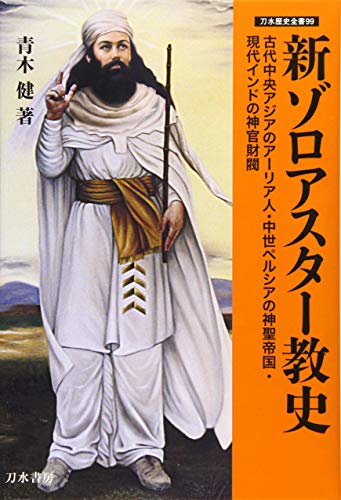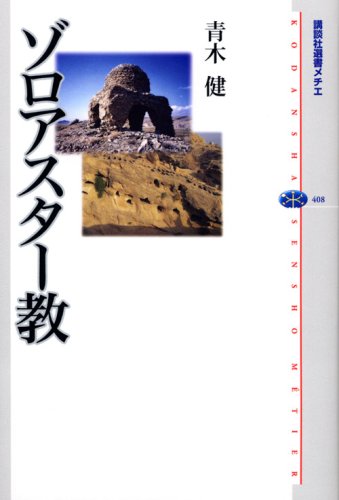- 著者
- 青木 健一
- 出版者
- 素粒子論グループ 素粒子論研究 編集部
- 雑誌
- 素粒子論研究 (ISSN:03711838)
- 巻号頁・発行日
- vol.60, no.3, pp.C14-C17, 1979-12-20 (Released:2017-10-02)
1 0 0 0 OA ディケンズとピカレスク遺産 (森田孟教授退職記念号)
- 著者
- 青木 健
- 出版者
- Seijo University
- 雑誌
- Seijo English monographs
- 巻号頁・発行日
- no.42, pp.277-297, 2010-02
1 0 0 0 OA LHCで何が見える、と思いますか?(放談室)
- 著者
- 青木 健一
- 出版者
- 素粒子論グループ 素粒子論研究 編集部
- 雑誌
- 素粒子論研究 (ISSN:03711838)
- 巻号頁・発行日
- vol.115, no.4, pp.207-208, 2007-10-20 (Released:2017-10-02)
1 0 0 0 OA ひらかなイソップ物語
- 著者
- 青木 健
- 出版者
- 東洋史研究会
- 雑誌
- 東洋史研究 (ISSN:03869059)
- 巻号頁・発行日
- vol.65, no.3, pp.614-583, 2006-12
This study begins with a reexamination of the research of S. Wikander that was conducted 60 years ago on the geographical transition of the iconography of the imperial ideology of the Sassanian kingdom. The study also incorporates the achievements of research on Zoroastrianism, from Wikander to the present day, and then hypotheses that the reason that the Sassanid kings moved their place of pilgrimage to Azerbaijan after the 5th century was associated with the sacred fire, Adur Gusnasp, in Siz and the imperial throne, Takht-i Taqdis. The author has drawn upon evidence from archaeological and written material (in Pahlavi, Arabic, and early-modern Persian) and art historical hypotheses, to create a compilation of fact, legend, and theories on both. As a result, I was able to come up with a chronology based on the weight of the facts. In addition, I sought the reasons for the changes seen in the chronology in light of advances in the study of Zoroastrianism since the time Wikander. As a result the following prospect on the holy fire and the sacred throne were attained. Firstly, the author conjectures that as regards the holy fire, Adur Gusnasp, there was a relationship in which "changes in Zoroastrian thought" resulted in the "modification in imperial ideology of the Sassanid kingdom." In short, there was a chain of influence during the 5th century, from the "linking of the legend of the founder to of Azerbaijan" to "royal pilgrimage to Azerbaijan after the king's enthronement" to the "iconoclastic movement" and finally to the "destruction of stone relief of Xwarnah, symbolizing the right to rule" and the "increase in the importance of the sacred fire of Adur Gusnasp." As regards Takht-i Taqdis on the other hand, it appears to have been a temporary phenomenon based on the initiative of Khosrow II, and I am unable to posit any influence of Zoroastrian thought. The imperial throne can be thought of as an artifact of the attempt by Khosrow II, who held a firm grasp on imperial legitimacy inherited from his grandfather Khusrow I to construct his own imperial ideology free from Zoroastrian thought by highlighting the glory of his military exploits. However, due to a lack of detailed records, it was impossible to specify just what the nature of ideology that might have been.
1 0 0 0 OA きょうだい構成の視点からみた心理的距離に関する実証的研究
- 著者
- 星野 翔一 青木 健一 福住 紀明 山口 正二
- 出版者
- 日本カウンセリング学会
- 雑誌
- カウンセリング研究 (ISSN:09148337)
- 巻号頁・発行日
- vol.44, no.2, pp.127-135, 2011 (Released:2016-03-12)
- 参考文献数
- 13
本研究では,きょうだい構成と性格特性・シャイネス特性・心理的距離との関連性を検討することを主たる目的とした。性格特性を測定するため,柳井・国生(1987)が作成した新性格検査を用いて,共感性・自己顕示性・持久性を測定した。次に,シャイネス特性を測定するため,鈴木ら(1997)が作成した早稲田シャイネス尺度を用いて,行動(消極性)・感情(緊張・過敏さ)・認知(自信のなさ)を測定した。最後に,心理的距離を測定するため,山口ら(1989)が作成した心理的距離測定用スケールを用いて,被験者と家族・教員・ペット間の心理的距離を測定した。その結果,きょうだい構成と性格特性・シャイネス特性・心理的距離が,おおいに関係していることが明らかにされた。性格特性・シャイネス特性・心理的距離において,きょうだい構成は重要な要因であることが示唆された。
1 0 0 0 ザ・ゴール
- 著者
- エリヤフ・ゴールドラット ジェフ・コックス原作 青木健生脚色 蒼田山漫画
- 出版者
- ダイヤモンド社
- 巻号頁・発行日
- 2014
1 0 0 0 OA ゾロアスター教書籍パフラヴィー語文献『デーンカルド』第3巻訳注・その2
- 著者
- 青木 健
- 出版者
- 東京大学東洋文化研究所
- 雑誌
- 東洋文化研究所紀要 (ISSN:05638089)
- 巻号頁・発行日
- vol.147, pp.192-141, 2005-03
The Dēnkard is one of the most voluminous Zoroastrian Book Pahlavī literature, edited by Zoroastrian high priests, Ādurfarrōbay-ī Farroxzādān and Adurbād-ī Ēmēdān in the 9^<th> and 10^<th> centuries.Here presented is an annotated transcription and Japanese translation of its third volume, which consists of 420 polemics against bad religions-Manichaeism, Judaism and Islam.Our process of preparing this translation can be divided into two steps.1. The late Prof. Gikyō ITŌ made a Pahlavī letters' transcription and its Japanese translation preciously corresponding to Madan's Dēnkard edition. Unfortunately, however, he passed away before completion this work.2. After Gikyō ITŌ's death, Takeshi AOKI made his work up-to-date, and added ① linguistic commentaries on Pahlavī letters' transcription and ② religious commentaries on Japanese translation.This time we can print only the 10^<th> chapter to the 26^<th> chapter, but we hope publishing serially the whole transcription and translation of the Dēnkard Book III in this Memoirs.
- 著者
- 青木 健一
- 出版者
- 素粒子論グループ 素粒子論研究 編集部
- 雑誌
- 素粒子論研究 (ISSN:03711838)
- 巻号頁・発行日
- vol.80, no.4, pp.D51-D71, 1990-01-20 (Released:2017-10-02)
1 0 0 0 OA 外地引揚者収容と戦後開拓農民の送出 : 長野県下伊那郡伊賀良村の事例
- 著者
- 青木 健
- 出版者
- 社会経済史学会
- 雑誌
- 社会経済史学 (ISSN:00380113)
- 巻号頁・発行日
- vol.77, no.2, pp.227-248, 2011-08-25 (Released:2017-05-24)
本稿では,長野県下伊那郡伊賀良村上殿岡・下殿岡区を事例に,敗戦後の外地引揚者の収容や戦後開拓農民の送出の実態を,戦後農村社会の再出発との関わりで明らかにする。当該区では,多数の外地引揚者が転入する中で,敗戦後の再出発をむかえた。その過程において,既存農村社会の農家の大部分は,所属更生組合内で互いに緊密な耕作地の融通を行いながら,耕作反別と世帯規模のバランス調整を行いつつ,農地改革期を経過した。一方で外地引揚者は,そうした耕作権の融通関係の外におかれ,引揚者の大部分が転入後に再転出するという不十分な収容状況にあった。こうした中で,伊賀良村の公民館報では,満州からの引揚者による在満体験を踏まえた農政・農業経済論が掲載されたのに加え,戦後開拓に関する啓蒙・推奨記事が掲載された。それらを受けて,当該区からは村外へ戦後開拓農民が送り出された。まず既存農家からは,零細農家の挙家離村や農家の傍系世帯員の転出のかたちで開拓農家が送り出された。さらに引揚者からは既存農家の場合を上回る開拓農家が送り出されたのである。
1 0 0 0 タイ国の水事情 : 聖なる水から灯籠流しまで
- 著者
- 青木 健作
- 出版者
- 公益社団法人 日本船舶海洋工学会
- 雑誌
- らん:纜
- 巻号頁・発行日
- vol.12, pp.37-41, 1991
1 0 0 0 OA 障害者歯科医療における障害のある子どもをもつ親への支援 ―学際的研究からみえる現象―
- 著者
- 村上 旬平 稲原 美苗 竹中 菜苗 青木 健太 新家 一輝 松川 綾子 有田 憲司 秋山 茂久
- 出版者
- 一般社団法人 日本障害者歯科学会
- 雑誌
- 日本障害者歯科学会雑誌 (ISSN:09131663)
- 巻号頁・発行日
- vol.38, no.1, pp.16-23, 2017 (Released:2017-06-30)
- 参考文献数
- 15
障害者歯科医療現場にはさまざまな「生きづらさ」のある人が来院する.歯科治療や歯科保健を進めるうえで,障害当事者だけでなく親への支援が必要となる場合も多い.本研究では障害者歯科医療での親支援について,障害者歯科学,臨床哲学,臨床心理学および小児看護学による学際的検討を行った.大阪大学歯学部附属病院障害者歯科治療部に受診する障害当事者および家族に心理的支援の必要性を問うアンケートを実施しそのニーズを探った.その後障害のある子どもをもつ親を対象とした心理カウンセリングを7名に実施し,哲学対話を18回開催した.心理カウンセリングでは親に来談意欲の高さと,自分自身を語りの中心におく人が多い特徴がみられた.哲学対話では親の日常生活の中での「生きづらさ」が明らかとなり,哲学対話の場で互いの知識や経験などの情報交換が行われた.それによって障害当事者とその親の日常生活での障害者歯科の位置付けが明らかとなり,障害者歯科での対応が,親には安心感として伝わっているということが描き出された.本研究を通じ障害者歯科医療現場での親支援ニーズが存在し,親に「物語る」「語り合う」場所を提供することが,当事者の生活に寄り添えるケアを考え,多職種の支援をつなげ,新しい支援ネットワークの構築に寄与するとともに,当事者からのフィードバックが障害者歯科医療の質的向上に寄与する可能性が示された.
- 著者
- 青木 健
- 出版者
- 政治経済学・経済史学会 ; 2002-
- 雑誌
- 歴史と経済 : the journal of political economy and economic history (ISSN:13479660)
- 巻号頁・発行日
- vol.58, no.4, pp.1-15, 2016-07
- 著者
- 青木 健一郎 松本 誉史 今田 秀樹 鈴木 健太郎 澤口 文彦 鈴木 奈々 西 孝明 藤岡 大輔
- 出版者
- 一般社団法人電子情報通信学会
- 雑誌
- 電子情報通信学会ソサイエティ大会講演論文集
- 巻号頁・発行日
- vol.2006, no.1, pp."S-33"-"S-34", 2006-09-07
1 0 0 0 IR ゾロアスター教書籍パフラヴィー語文献『デーンカルド』・第3巻訳注・その1
- 著者
- 青木 健
- 出版者
- 東京大学東洋文化研究所
- 雑誌
- 東洋文化研究所紀要 (ISSN:05638089)
- 巻号頁・発行日
- vol.146, pp.72-41, 2004-12
An Annotated Translation of Zoroastrian Book Pahlavī Literature, the Dēnkard Book III: No. 1by Takeshi AOKIThe Dēnkard is one of the most voluminous Zoroastrian Book Pahlavī literature, edited by Zoroastrian high priests, Ādurfarrōbay-ī Farroxzādān and Adurbād-ī Ēmedēn in the 9^th and 10^th centuries.Here presented is an annotated transcription and Japanese translation of its third volume, which consists of 420 polemics against bad religions-Manichaeism, Judaism and Islam.Our process of preparing this translation can be divided into two steps.1. The late Prof. Gikyō Itō made a Pahlavī letters' transcription and its Japanese translation preciously corresponding to Madan's Dēnkard edition.Unfortunately, however, he passed away before completion this work.2. After Gikyō Itō's death, Takeshi AOKI made his work up-to-date, and added ① linguistic commentaries on Pahlavī letters' transcription and ② religious commentaries on Japanese translation.This time we can print only the 6^th chapter to the 9^th chapter, but we hope publishing serially the whole transcription and translation of the Dēnkard Book III in this Memoirs.
1 0 0 0 遺伝子・文化の共進化に関する理論集団遺伝学的研究
遺伝子と文化の共進化の事例研究を3つ行った。1.成人乳糖分解者が多い人類集団で家畜の乳を飲む習慣が普及していることを説明するため、3つの仮説が提唱されている。乳糖分解者と飲乳者の共進化を集団遺伝学のモデルに基づいて理論的に研究し、それぞれの仮説の妥当性を検討した。まず、文化歴史的仮説あるいはカルシウム吸収仮説が成り立つためには、従来言われているよりはるかに強い自然淘汰が要求されることを示した。また、乳に対する好みの効果を検討し、逆原因仮説が成り立つためには乳糖分解者と分解不良者の間で好みに違いがあることが必要で、しかも文化伝達係数がある不等式を満足しなければならないことを示した。逆に、好みの違いが大きすぎると、前者2仮説が成り立ちにくいことも分かった。2.手話とは聾者の自然言語であり、文化伝達によって維持されている。一方、重度の幼児期失聴の約1/2が遺伝性であり、その約2/3が複数の単純劣性遺伝子によって引き起こされている。劣性遺伝の特徴として聾者が世代を隔てて出現する傾向にあるため、親から子への手話の伝達が阻害される。遺伝子と文化の相互作用の観点からこの問題を解析し、劣性遺伝子が2つ存在する場合、手話が失われないためには聾者同士の同類結婚が重要であることを示した。実際、日本や欧米で約90%の同類結婚率が報告されており、手話という特殊な文化現象の存続が聾に関する同類結婚によって可能になっていることが暗示された。さらに、聾学校などで家族以外の者から手話を学習する機会がある場合について検討を加えた。3.文化伝達能力と父親による子育てが共進化する可能性を理論的に検討した。有性一倍体モデルを完全に記述し、平衡点の同定と安定性解析を行った。その結果、母親からの文化伝達の効率がよく、父親からの文化伝達に補助的な意義しかない場合、文化伝達能力と父親による子育てがほぼ独立に進化することが分かった。一方、父親からの文化伝達が特に重要である場合には強い相互作用が見られ、文化伝達能力と父親による子育ての共進化が促進される。また、より現実的な二倍体モデルを部分的に解析したが、本質的な結果において一倍体モデルと一致した。さらに、父性信頼度の低下による効果も検討した。
- 著者
- 青木 健
- 出版者
- 東京大学東洋文化研究所
- 雑誌
- 東洋文化研究所紀要 (ISSN:05638089)
- 巻号頁・発行日
- vol.167, 2015-03
As a beginning of this small paper on the Āzar Kayvān School, a good starting point is the outline of Āzar Kayvān School Studies until 2014, especially the publication data of Āzar Kayvān School’s eight Persian treatises and their translations. Prior interpretations of Āzar Kayvān school’s religious thought can be best summarized in Rezania 2014 and Sheffield 2014a. In the latter half of the 20th Century, Āzar Kayvānian religious thought is always explained as a Zoroastrian branch of Suhrawardī Maqtūl’s Illiminationism. Representative scholars of this interpretation are Henry Corbin (especially Corbin 1989), Fath Allāh Mojtabā’ī (Mojtabā’ī 1989), Seyyed Hossein Nasr (several surveys of Islamic mysticism), Kevin R. D. Shepherd (Shepherd 1988) and Takeshi Aoki (Aoki 2001a and 2001b). At the turn of the century, however, the trend changed drastically. Some scholars began to connect Āzar Kayvān School with other religious thoughts in Safavid Iran and Mughal India. Takeshi Aoki tried to connect Āzar Kayvān School’s Eschatology with Dīn-e Ilāhī (Aoki 2002a), and connect the contents of the Jām-e Kay Khosrow with the soteriology of the Nūrbakhsh order (2002b). Kathryn Babayan supposed close connection between Āzar Kayvān School and the Nuqtavī order (Babayan 2002). Since 2009, however, I continue to search for the Zoroastrian Persian MSS possessed at Islamic MSS libraries both in Iran and India and, in the course of those researches, I discovered some new MSS of already-known Āzar Kayvānian treastises (not in Yazd or Kermān, but mainly in the western part of Iran). According to their colophons, a part of them were written before the publication of lithographies in the 19th century and there are some differences between the lithographies and those MSS. So we must look more carefully into the MSS data to prepare new editions of Āzar Kayvānian literature. In this paper, I would like to take up a Persian treatise as a possible Āzar Kayvānian lost treatise, Dāstān-e Mōbedān Mōbed Dādār Dāddukht va Keyfīyat-e ān in the Majles 13522 Codex possessed at the National Congress Library of Iran (Tehrān).
1 0 0 0 OA 単なる喪失ではない : 加齢に伴う認知症における自己のあり方
- 著者
- シェル リサ・フォークマーソン 青木 健太 浜渦 辰二
- 出版者
- 大阪大学大学院文学研究科臨床哲学研究室
- 雑誌
- 臨床哲学 (ISSN:13499904)
- 巻号頁・発行日
- vol.16, pp.82-109, 2015-03-31
原著者:シェル, リサ・フォークマーソン





